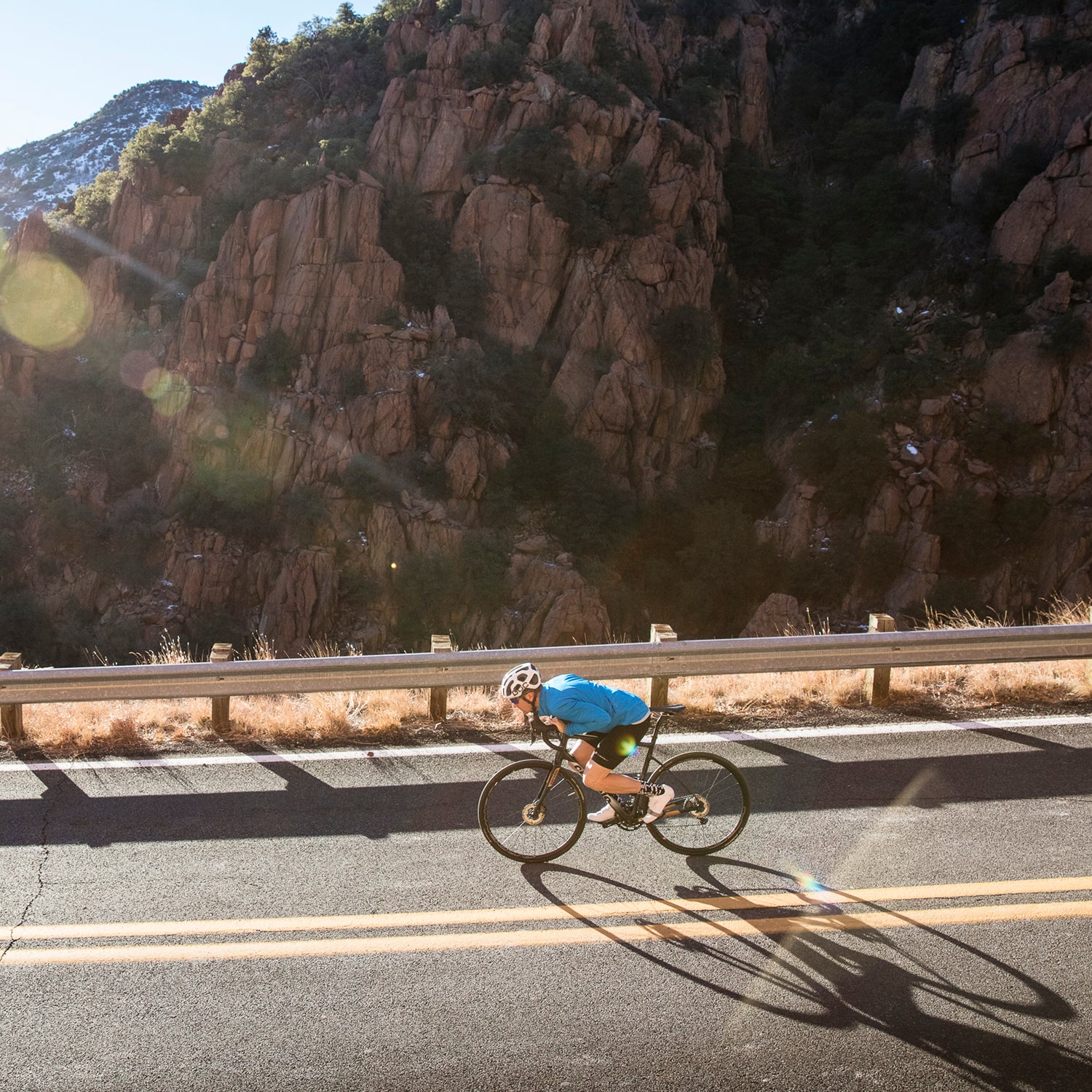The Takeaway
The Good: High comfort and a very low frame weight. Planted, super-stable descending abilities. Disc brakes are superior and, for 99 percent of us, should be standard.
The Bad: It fits up to 32c tires, but we want more clearance. Low-speed handling is spongy and slow, but that picks up with velocity. Impressions of the aesthetics were mixed, with about half the testers calling it “dull” and the other half leaning toward “classy.”
The Verdict: Cervélo has crafted a machine that’s fast but still easy on the body. The head tube isn’t smokestack tall like some comparable models, but it’s still oversized and the compact geometry won’t suit traditionalists. Meanwhile, the dropped tube-seat stay junction and the wire-thin fork combined with the fatter tires make for a seriously comfortable ride that can still keep up. It’s a comfortable bike that the racer crowd can finally get behind.
Though “endurance” and “comfort performance” bikes have gotten a bit of a bad rap—they sound ponderous and slow, and some models indeed ride that way—the truth is that this genre of bikes has come a long way in recent years. Cervélo is a bit late to the party, which makes sense given its small size and racing heritage. And it’s precisely that DNA for speed : the engineers clearly built the bike from the company’s existing race geometries, then added comfort (rather than the other way around).
Specs
- Weight: 850 grams for the frame
- Drivetrain: Dura Ace Di2 9070
- Price:��$9,000��
The Frame
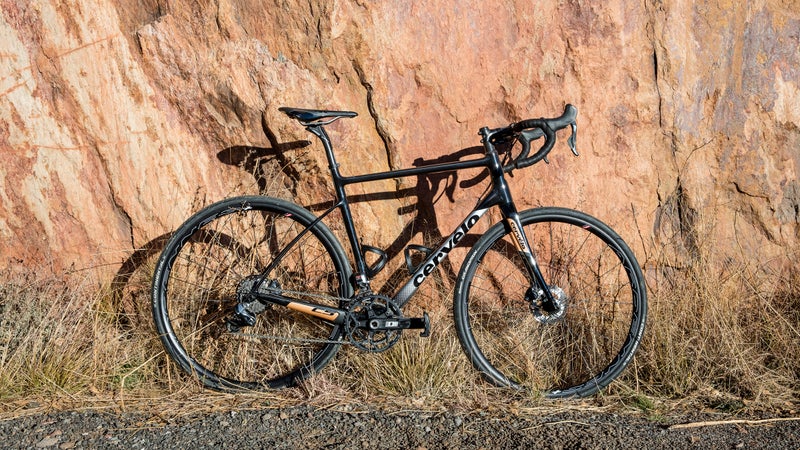
Comfort in a bike frame normally increases weight, but at 850 grams for the frame, which is competitive with many brands’ standard road machines, the all-carbon fiber C5 is surprisingly lightweight. That eliminates the first and biggest complaint we have with the endurance genre.
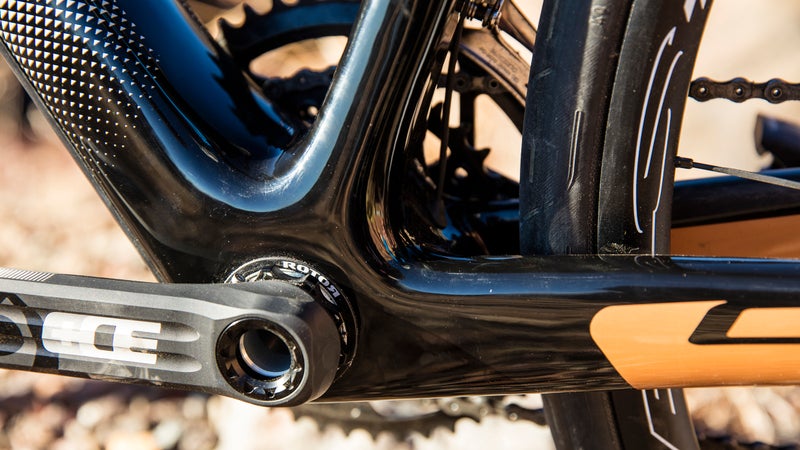
Our second quibble is that these bikes are often too tall and upright, and while the C5 is definitely more relaxed than the R5, Cervélo has avoided the beach-cruiser feel with some smart geometry tweaks. The wheelbase is longer and bottom bracket lower, which accounts for the bike’s stability, but also means that the fit can be slightly more relaxed without an unsightly tall head tube. Add in a slacker head angle than normal (71.5 degrees) and a more raked-forward fork, and you have a bike that manages to feel both fast and road-smoothing.
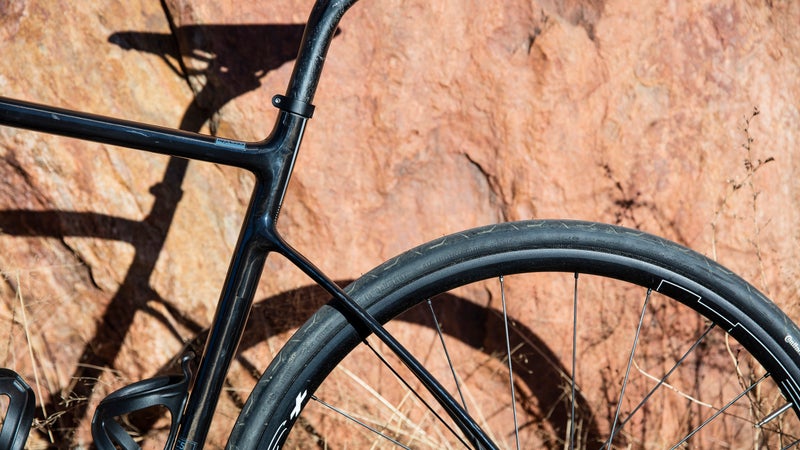
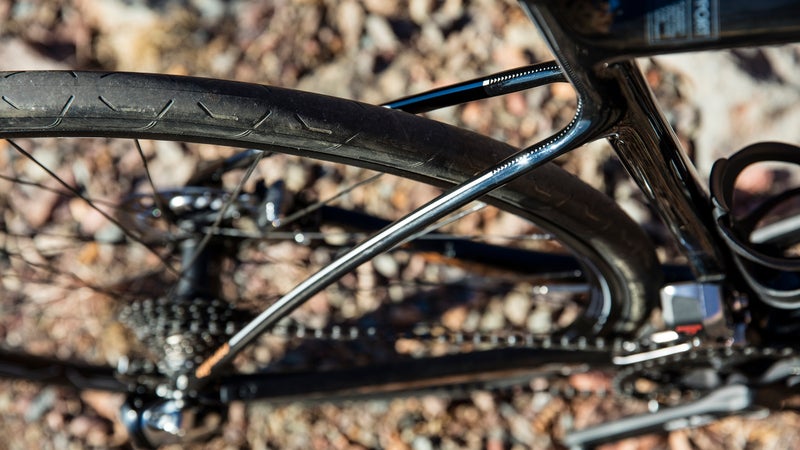
The frame keeps Cervélo’s trademark Squoval shaping in the down tube—the square-oval combo is said to yield aero benefits without resorting to full aero shaping (and its ensuing rough ride)—but the bowed-out seat stays and their lowered junction on the seat tube are new, which partly accounts for the added rear compliance. All the other niceties of a serious high-end bike are here, including internal cable routings handled neatly by rubber gasket fitments that adapt to every mechanical or electronic drivetrain on the market, and thru-axles front and rear, which are a must with disc brakes. And though Cervélo isn’t calling the C5 a “gravel bike” per se, there’s a large rubber bash guard on the bottom of the down tube and meaty rubber chain stay protector that suggest the bike is capable of more than just pavement.

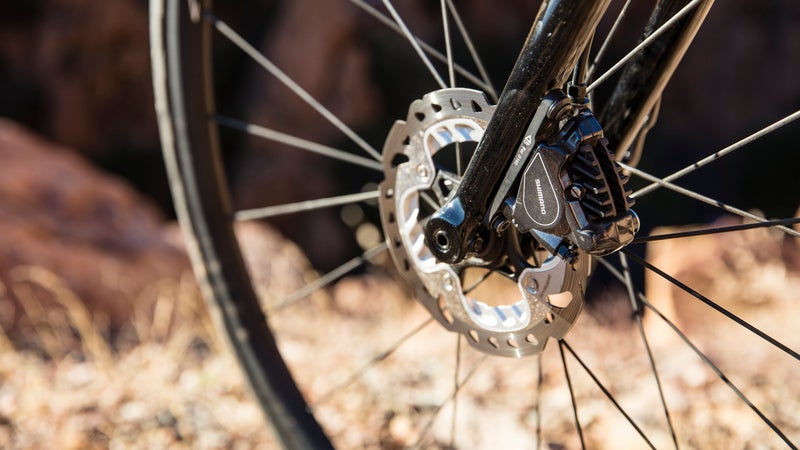
The Components
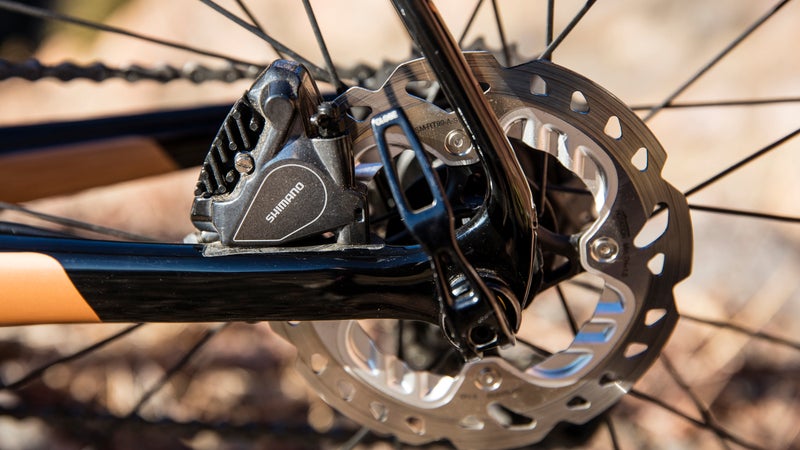
Because our testing took place so early in this bike’s production cycle, the only model available was the top-line C5 Dura Ace Di2 9070 model, meaning there’s not a part to sniff at. The Shimano Di2 was as flawless as ever and remains, at least as far as shifting performance, the gear by which every other drivetrain is measured. (SRAM eTap takes top honors for its wireless tech.) The bike gets a Rotor crank instead of Dura Ace because the Shimano setup won’t work with Cervélo’s ultra-stiff BBright bottom bracket system without using an adapter. A few testers would have preferred larger gearing than the stock 50-34 chain rings, but clearly Cervélo sees the C5 as a bike for enthusiasts, not racers. Personally, I favor the compact gearing as it allows me to pedal a higher cadence and thereby save my legs.
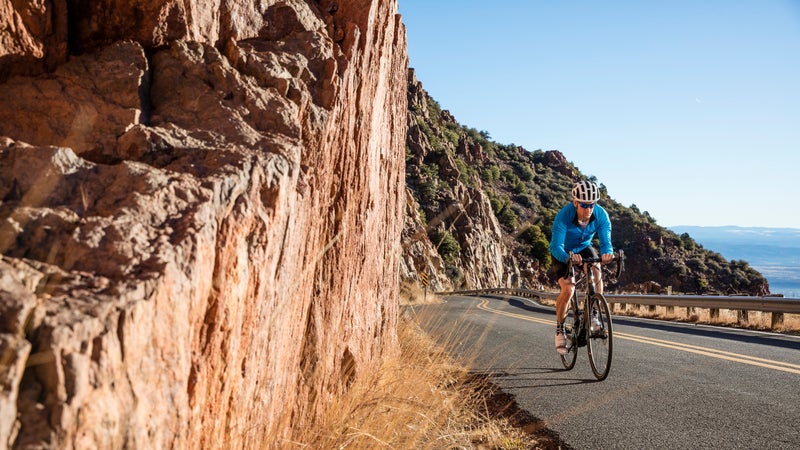
There was no arguing over disc brakes. They are perfect for this application (every application, in my humble opinion), and riders cooed over the modulation and stopping power relative to how little effort it took to actuate them. Like Shimano’s drivetrain, its disc brakes should be considered definitive in terms of performance and reliability.
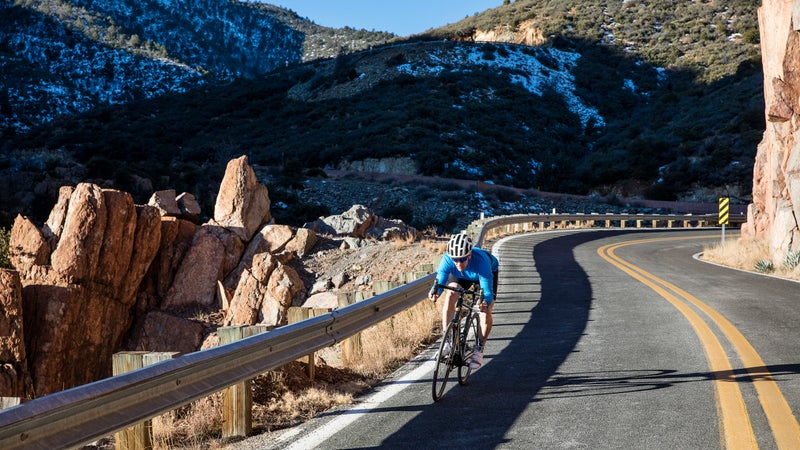
Highlights of the rest of the kit included: an FSA cockpit (including nicely shaped shallow-drop bars), HED Ardennes Plus LT wheels, and 28c Continental Grand Prix tires that were grippy and fairly plush feeling (though, as already mentioned, we’d happily have run 32s and craved space for even wider).
The Ride
The magic of the C5 is that it manages to feel simultaneously fast and light but also stable and totally forgiving. The frame design and wide tires give it a Caddy-smooth ride, and the long wheelbase and low bottom bracket make for a totally rooted, Velcroed to the road feel. Holes and dips and grooves that would be spine-tingling on an R5 feel muted aboard the C5, as if all of those obstacles are coated in carpet padding. The bike is powerful while smashing out flats and rollers, and it is one of the most at ease bikes we’ve ridden in a big group thanks to the stability and solid tracking.
It’s true that the bike feels slightly awkward and sluggish to turn over when climbing hard on steeps out of the saddle, likely because of that higher front end and longer wheelbase. And steering isn’t as razor sharp as a full-fledged race bike, though Cervélo has done a remarkable job preserving some of the quick, responsive feel that defines all of its bikes.
The slightly wonky climbing feel of the taller, longer geometry was forgotten as soon as I began a descent. The C5 felt laugh-out-loud stable, almost to the point that I was tempted to take both hands off the bars and no-hand it down mountain passes. The steering is still slightly slow, but here it’s a boon. You don’t dive into corners, as you would on a mogul ski, but carve the bike like giant slalom boards, with the same power, stability, and sureness. And the vertical compliance and big tires had me comfortable sticking rutted lines that would have sent harder-edge bikes skittering.
Mostly, though, this bike just feels like a very comfy road bike, able to plow along for hours without the hand, wrist, tricep, and neck fatigue that comes with stiffer, longer, lower bikes. And that, for all of us non-professional riders, should be a big selling point.
The Competition
The market is flush with endurance road machines that claim to smooth the ride these days: some that work great and others that are simply gimmicks. Probably the closest comparable model to the C5 is the Cannondale Synapse, though the C5 somehow manages to feel both more compliant as well as faster, likely thanks to the bike’s low frame weight. The new Trek Domane SLR also compares well, and is definitely a softer ride with the rear decoupler all the way open. However traditionalists will probably relate better to the looks and simplicity of the Cervélo. Other bikes in this genre include the GT Grade and the Specialized Diverge, with the C5 clinging harder to the road side of the all-road equation than those two models.
The C5 is a far more premium bike than any of those options, with only two specs: the Di2 version we tested for $9,000 and a Dura Ace mechanical setup for $7,000. Cervélo also offers the C3, which is built in the same molds as the C5 but with slightly lower-grade carbon, which means you get a very similar, but heavier bike (around 130 grams) with parts ranging from Ultegra Di2 and Ultegra to Force CX1 for between $4,300 and $5,500. For my money, the Ultegra-level C3 is probably the best value in the bunch and the one that I’d consider for my personal ride. It’s still not cheap, so budget shoppers may be better served by the competition.
The Verdict
In the C5, Cervélo has built a bike with all the technology, engineering, and spec detail that’s normally reserved for Pro Tour machines, but in a more comfortable, easier-on-the-body package. It reflects the broadening trend in the road market to create more versatile, less severe, non-race bikes.
Watch and see what we thought of the C5 at our annual bike test earlier this year
The ultimate expression of this, at least at the moment, is last year’s Gear of the Year winning Open U.P., and of course the Cervélo is only a very intermediate step between a standard road racer and the fat-tired Open. But if there’s one thing I’m convinced of, it’s that the vast majority of riders will be better served by a C5, an Open U.P. or something between the two than by the other-end-of-the-spectrum race machine. Think of it like this: Sure an F1 race car would be fun to drive—once, on the track—but you’d never choose it for everyday use. Continuing with the analogy, a Porsche Cayenne, the equivalent of the C5, is plenty fast but still an easy, daily driver.
My only real qualm with the C5 and bikes like it (including the Diverge, the Grade, the Domane, the Synapse, etc.) is that they simply don’t go far enough in terms of comfort, easy handling, and tire width. But what I realized riding the C5 is that many people may prefer this intermediate option—not everyone wants or needs balloon tires that can handle hours of dirt and gravel. To that end, the C5 might just be the ultimate expression of the middle ground, a “comfort” bike that road racers can still love.


